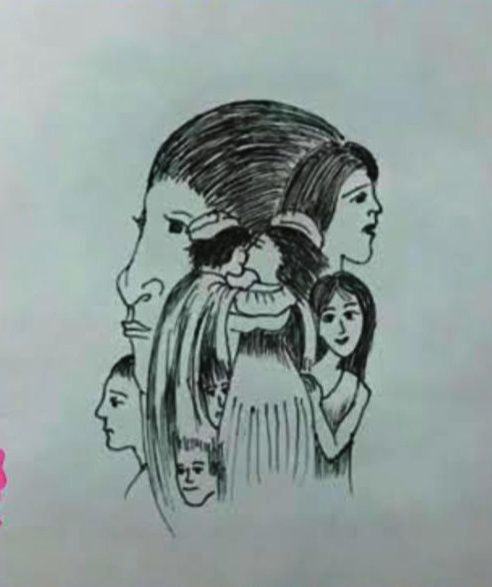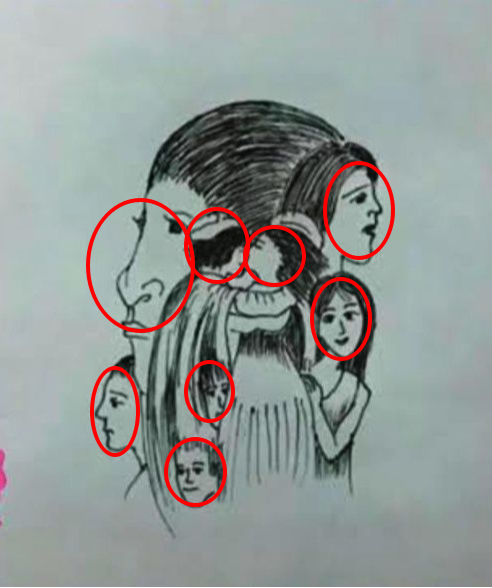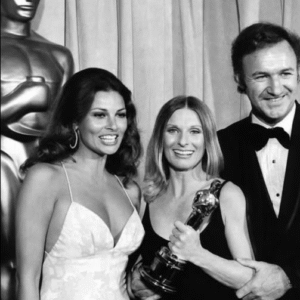Unveiling the Hidden Faces: Exploring Multi-Figure Optical Illusions in Art
The Fascination of Optical Illusions in Modern Art
Have you ever stared at a drawing and suddenly spotted a completely different image hiding in plain sight? That rush of discovery is what makes optical illusions so addictive. In the sketch above, a cluster of women embracing, hugging, and standing together seamlessly forms the profile of a giant face. This clever play on positive and negative space taps into our brain’s pattern-seeking tendencies, flipping what we see from one interpretation to another. Optical illusions like this one captivate our imagination by challenging our perception—inviting us to look twice, look deeper, and relish that satisfying “Aha!” moment when hidden images reveal themselves.

Decoding the Multi-Figure Profile Illusion
At first glance, you see a large-scale female profile: prominent brow, nose bridge, lips, and chin. But if you shift focus, you’ll notice at least seven individual figures—women with flowing hair, a child tucked in an embrace, and faces peeking from the edges. The artist carefully arranged each person’s silhouette—hair curves become the giant’s eyebrow, a back becomes the nose ridge, and a long braid forms the jawline. By balancing light and dark strokes, the drawing blurs boundaries between collective and individual forms. This dual-interpretation design exemplifies how clever line work and spatial arrangement can transform a simple sketch into a mind-bending puzzle.
Understanding Pareidolia: Why Our Brains Love Hidden Patterns
Pareidolia is the psychological phenomenon that makes us see faces in clouds, shapes in rock formations, or messages in toast crumbs. Evolution wired our brains to detect faces quickly—vital for social bonding and danger detection. Optical illusion artists harness this primal bias, embedding secondary images within a larger scene. In the multi-figure profile, your brain alternates between recognizing familiar human shapes and constructing the giant face. That back-and-forth switch engages both hemispheres—analytical and creative—resulting in a richer viewing experience. Understanding pareidolia not only explains why illusions enthrall us but also offers insight into how our perception shapes reality.

Techniques Behind Multi-Figure Illusions
Crafting such illusions requires precision and artistic intuition. Here are key techniques artists use:
- Layered Silhouettes: Each small figure’s outline doubles as a feature in the larger image, demanding perfect alignment.
- High-Contrast Shading: Dark and light areas emphasize important contours, guiding the viewer’s eye to alternate interpretations.
- Strategic Composition: Placing figures at varying scales ensures balance—too many large shapes can obscure the hidden face, too many small ones can drown it.
- Continuity of Lines: Flowing lines—like hair or drapery—bridge separate figures into a unified form, seamlessly morphing from one shape to the next.
- Subtle Detailing: Fine details (eyes, fingers, hair strands) lend realism to small figures while serving as texture for the giant profile.
By combining these methods, artists produce illusions that sustain repeated viewings, each time revealing new surprises.
Famous Examples of Multi-Figure Illusions in Art History
This modern drawing joins a rich lineage of multi-figure illusions. Remember Salvador Dalí’s “The Hallucinogenic Toreador,” where Venus’s navel becomes a bullfighter’s helmet? Or Octavio Ocampo’s gravity-defying metamorphic portraits, where everyday objects shape hidden faces? Even classical works, like Giuseppe Arcimboldo’s portrait-made-of-fruit series, exemplify this tradition: grapes form cheeks, apples become eyes, and pear beards complete the face. These masters understood that dual imagery evokes curiosity, transforming passive viewing into active discovery.

Creating Your Own Multi-Figure Illusion: A Step-by-Step Guide
Feeling inspired? Try crafting your illusion:
- Choose a Primary Shape: Decide on a large profile or object you want to hide—a human face, animal silhouette, or landmark.
- Sketch Key Contours: Lightly outline the outer shape on paper, marking critical points (forehead curve, nose tip, chin).
- Divide Into Segments: Break the profile into regions—brow area, cheek, jaw—and envision small figures filling each segment.
- Draft Mini Figures: Roughly draw people, animals, or objects that align with each region’s shape. Scale and rotate them to match the silhouette.
- Refine Lines and Shading: Emphasize shared contours with strong, continuous strokes. Add shading to separate figures and the overarching shape.
- Test and Tweak: Show your sketch to friends without explanation. Note which hidden figures or the large form they spot first, then adjust contrasts or placements accordingly.
- Finalize the Artwork: Ink or darken lines, clean up stray marks, and present both interpretations side-by-side—inviting viewers to switch perspectives.
This process hones both your technical skills and your understanding of perceptual psychology.

Applications of Optical Illusions Beyond Art
Optical illusions, especially multi-figure designs, have practical uses too:
- Marketing and Advertising: Brands use dual-image ads to grab attention—like a product turning into a lifestyle scene upon closer look.
- Therapy and Brain Training: Therapists employ visual puzzles to enhance focus, improve cognitive flexibility, and support neurorehabilitation.
- Education: Teachers use illusions to illustrate how our brain processes visual information, sparking lessons in psychology, neuroscience, and art.
- Security and Camouflage: Military and wildlife experts study pattern disguises, inspired by nature’s own camouflage, to develop stealth technologies.
By understanding the mechanics behind illusions, professionals across fields leverage perception science for engagement, learning, and innovation.
Why Multi-Figure Illusions Matter Today
In our visually saturated world, images that demand active interpretation stand out. Multi-figure optical illusions invite us to slow down, engage deeply, and question our first impressions. They remind us that reality often hides deeper layers—whether in art, everyday life, or human relationships. By exploring these hidden faces, we cultivate patience, sharpen observation, and embrace the unexpected. In a time of rapid scrolling and fleeting attention spans, the simple act of finding a second image within a drawing reconnects us to wonder and the joy of discovery.

Conclusion: See Beyond the Surface
The multi-figure profile painting captures a timeless magic: the ability to reveal two worlds within one canvas. As you study the layered silhouettes of women forming a giant face, remember that perception is never fixed—each glance can unlock new secrets. Whether you’re an art lover marveling at clever compositions, a budding artist experimenting with dual imagery, or a curious mind intrigued by pareidolia, multi-figure illusions offer endless fascination. Next time you encounter a complex sketch or a world seemingly ordinary, pause and ask yourself: “What else is hiding in plain sight?” Happy exploring!





